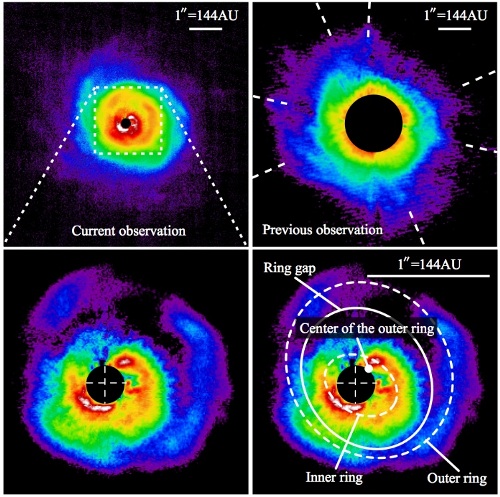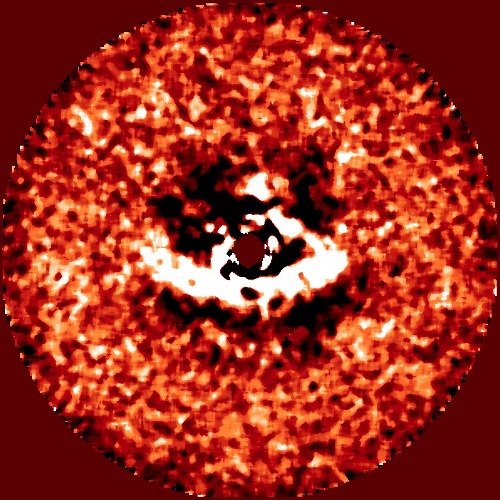Protoplanetary disks present huge challenges, but we need to learn more about them to make sense of our exoplanet catalog. We’re interested in learning about the two primary theories of planet formation — core accretion from colliding bodies of rock or ice and gravitational instability in the disks themselves. But protoplanetary disks are dim compared to their central star, and our studies thus far have been more or less limited to the outer envelope of the disk structure.
What that means is that we’re looking at a scale that’s much larger than our own Solar System, not sufficient for the kind of detailed observation we’d like to make. Fortunately, we have technologies like coronagraphs, that can mask the bright light of the central star, and adaptive optics that can compensate for the blurring effects of the Earth’s atmosphere. Now we have new images from the Subaru telescope in Hawaii, which is using advanced versions of both technologies in an instrument called HiCIAO (High Contrast Instrument for the Subaru Next Generation Adaptive Optics). And our view of protoplanetary disks is becoming a bit sharper.
Consider the very young star AB Aur in the constellation Auriga, which now yields the sharpest image of a disk ever taken. You can see the result in the images below:
Image: Near-infrared (1.6 micron) images of AB Aur. The top panels compare images taken by HiCIAO and CIAO [the older instrumentation that HiCIAO replaces]. Both images have a field of view of 7.5″ by 7.5″. Top left: Image taken by HiCIAO using a coronagraphic occulting mask with a 0.3″ diameter. Top right: Image taken by CIAO using a software mask with a 1.7″ diameter. The bottom panels show close-up views of the inner part of AB Aur’s disk. Both images have a field of view of 2.0″ by 2.0″. Bottom left: Image has a coronagraphic occulting mask with a 0.3″ diameter. Bottom right: Image includes labels of its prominent features. The central position (0, 0) refers to the location of the star. Ellipsoids in dashed lines show the outer and inner rings. The solid ellipsoid indicates the wide gap between the rings. The “+” shows where the star is. The filled circle is the center of the outer ring. Credit: Subaru Telescope/SEEDS collaboration.
Here we’re looking at a developing system that is only about a million years old, located some 460 light years from Earth. The details visible in the HiCIAO images show fine details of the disk’s inner structure that are on a scale similar to Neptune’s orbit in our own Solar System. The bottom two images show close-ups of the inner disk and reveal its irregularities — note that the centers of the visible double rings do not coincide with the position of the central star. Researchers believe these irregularities point to the existence of a giant planet that is not visible because it is obscured within the disk materials themselves.
The second star under examination is LkCa 15, several million years old and roughly as massive as the Sun. The Subaru work provides the first direct imaging of a gap in the protoplanetary disk here, as shown in the following image. Again we’re looking at features on a scale similar to Neptune’s orbit, seeing a lack of material near the central star that is evidently the result of a giant planet sweeping up leftover materials from early planetary formation.
Image: High-contrast near-infrared imaging of LkCa 15 disk. The central star is hidden by the dark brown area toward the center. The inner edge of the outer disk is visible. The white feature below the blocked out area is part of the disk illuminated by the central star. The opposite side of the disk is not readily visible. There is a gap between the inner boundary of the disk and the star, at a distance of about 50 AU (Astronomical Unit, the distance between the Earth and the Sun, about 150 million kilometers or 94 million miles. Credit: Subaru Telescope/SEEDS Collaboration.
The Subaru work, which is part of the SEEDS (Strategic Explorations of Exoplanets and Disks with Subaru) Project, gives us a glimpse of the advances we’re making in direct imaging of these tricky targets. The imagery of both stars is strongly suggestive of the presence of Jupiter-class planets that are affecting the structure of the disks, yielding the useful fact that within a scant million years, giant planets can be well along the way to formation.





Such young discs will be the biggest prize for Dyson-swarm civilizations seeking new systems to settle, replete with dispersed matter unsequestered in wasteful planetary gravity wells. The bigger the star, and the greater its luminosity, the bigger the Swarm that engulfs it: a ten-solar mass star could support 10^15 mega-habitats, probably requiring a million years to build.
Beautiful imagery! It amazes me that we’ve reach the level of observational sophistication necessary to see these disks in such detail and to be able to reliably infer the existence of young planets in orbit around them.
As for the comment about Dyson swarms, would the fact these young disks are full of much more debris than most older systems make the exploration of them more hazardous as a result?
Interstellar Bill: I agree with spaceman that a very debris rich disc might pose serious hazards for space habitats.
Plus the fact that a very young and very heavy star emits lots and lots of highly unpleasant radiation and in great variability.
Finally, such a heavy star does not live long.
Slightly but not entirely off-topic, and very fascinating: systemic site has some preliminary indications, from Kepler results, for an existing ‘planet-metallicity correllation for low-mass planets’:
http://oklo.org/2011/02/20/a-planet-metallicity-correlation-for-low-mass-planets/
Summarizing, the general idea is that the correllation between stellar mass and stellar metallicity on the one hand and planet occurrence on the other hand, which was already known for giant gas planets, also appears to hold for low mass planets, i.e. the sub-Neptunes and super-Earths that Kepler has revealed as being so common.
Paul, I think this is really worth a dedicated post!
Ronald writes re stellar metallicity findings:
Fear not, my friend, it’s already in the queue!
Because the nature of the technologies and weaknesses of an advanced civilisation are unknown, I cannot know if Interstellar Bill or Ronald are the more correct over the suitability of this star to such habitation. What I do know is that Ronald’s short life objections for such stars are not valid when applied to a colonising civilisation. It is true that such stars have insufficient time to evolve forms of life that are both indigenous and interesting, but one could argue that that actually makes them more interesting for colonisation as opposed exploration. In the Drake equation a typical value for L is 10,000 years, which is about a thousand times less that the life of the shortest lived stars. Even if prospective colonisers expect to last this long and plan that far in advance, it is hard to for us to rule out their prospects for migration.
IF exterritorial intelligences can easily ameliorate the effects of the hard radiation AND have an affinity for O‘Neil habitats AND have a thirst for energy, the greatest source of light will be their greatest prise for colonisation. If that is the case, one only needs to look at the night sky to find the answer to their preferred destinations. Suddenly it seems possible that they left the Solar system alone due to the dimness of our sun!
Rob: true what you say about even a few million years of lifespan of a massive star being very long by human standards and hence still being potentially useful from that perspective, just as it would be immensely useful if a terraformed Mars could retain its new O2-rich atmosphere for a hundred thousand years, even though that would be almost nothing by geological standards.
However: the nasty thing about very bright as well as very young stars is that they tend to emit enormous amounts of aggressive radiation, plus often being very variable.
An important criteria for stellar selection for an advanced civilization might be the (spectroscopic) nature and long-term stability of a star, not just sheer amount of radiation.
That timeframe seems unduly pessimistic. If a group of 10 habitats together can build one new habitat in 100 years, their number will double in ~700 years, ten-fold in ~2500 years, and grow to 10^15 habitats in a paltry ~35,000 years. Provided there are enough raw materials, but that was the assumption.